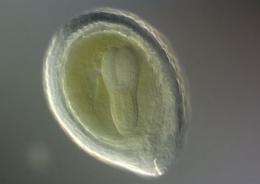How plants put down roots

In the beginning is the fertilized egg cell. Following numerous cell divisions, it then develops into a complex organism with different organs and tissues. The largely unexplained process whereby the cells simply "know" the organs into which they should later develop is an astonishing phenomenon.
Scientists from the Center for Plant Molecular Biology (ZMBP) of the University of Tübingen and the University of Wageningen, in cooperation with colleagues from the Max Planck Institute for Developmental Biology, have investigated how this process is controlled. Based on their studies of the thale cress, Arabidopsis thaliana, they have succeeded in demonstrating how the plant forms its first roots: the root founder cell in the tiny group of cells contained in the seed is activated by a combination of a plant hormone and a transcription factor. These insights could contribute to the breeding of plants with a particularly effective root system in the future. (Nature, advance online publication on March 10, 2010)
.jpeg)
In the seed of the thale cress, the embryo forms from the fertilised egg cell that initially divides into two daughter cells. One of these two cells later goes on to form almost the entire embryo, while the other generates connective tissue that anchors the embryo in the endosperm or nutritive tissue. When the embryo has grown into a small cluster of cells, the connective tissue cell that borders the embryo is stimulated by activating signals to become part of the embryo and form the root tissue. The scientists studied these processes in detail under the supervision of Gerd Jürgens and Dolf Weijers and succeeded in identifying several of the players involved in this complex regulatory network.
The formation of the root tissue depends firstly on the accumulation of the plant hormone auxin, which is channelled to the root founder cell by the embryo. This process is reinforced by the transcription factor MONOPTEROS. However, this is not sufficient on its own. The researchers concluded that MONOPTEROS must deliberately activate other genes. In a comprehensive survey of all of the genes activated by MONOPTEROS, they identified two genes that already play a role in embryonic development: TMO5 and TMO7 (TMO = Target of MONOPTEROS). Both of these genes are required for the formation of the root tissue. For this purpose, the protein formed by the TMO7 gene must migrate from the location of its emergence in the embryo to the root founder cell.
.jpeg)
"With TM07 we have identified a hitherto unknown intercellular signal for root formation in the embryo," says Gerd Jürgens. The detective work in the plant researchers' genetics laboratory does not end here, however. "Because the transcription factor TM07 is involved in other regulatory network of plant development, there can be no doubt that it holds further insights in store for us," says Jürgens.
More information: Alexandra Schlereth, Barbara Möller, Weilin Liu, Marika Kientz, Jacky Flipse, Eike H. Rademacher, Markus Schmid, Gerd Jürgens und Dolf Weijers, MONOPTEROS controls embryonic root initiation by regulating a mobile transcription factor. Nature, advance online publication on March 10th, 2010, doi 10.1038/nature08836
Provided by Max-Planck-Gesellschaft










.jpeg)







